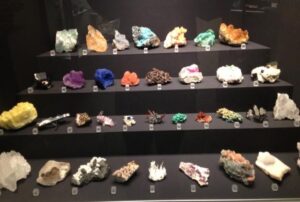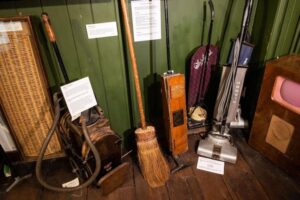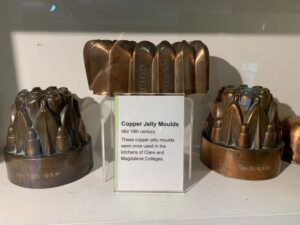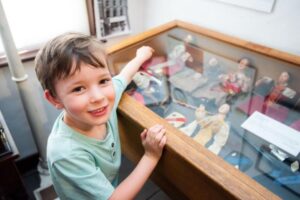Create your own collection and exhibition
What is a collection?
What do you think a collection is? Have a few moments to think about it and perhaps discuss this with family and friends. Then, continue reading to find out!
A collection is a group of objects that share something in common. Usually a collection has a theme that links all the items together. For example, you might collect rocks, stickers, paintings, etc. Anything that is not related to that theme or themes, might not be able to be part of the collection. Do keep these objects though as you may decide to add a different theme and expand your collection.

For example, this is a display of a collection of rocks.
The Museum of Cambridge collects objects that represent the social history of Cambridge and Cambridgeshire. This means everyday things from years past, about many different aspects of life and work in and around our city.

This is part of our collection: some old brooms and carpet cleaners, which people used to keep their houses clean.
Is there anything that you, or someone you know, collect? Do ask your friends and family
If you are not collecting anything at the moment, what would you like to start gathering? Think of things that you find particularly interesting or that you really like. You also need to think of ways in which you can choose objects for your own collection It is never late to start collecting if you want to.
The collection is more than its objects: exhibiting your collection
The collection needs information about the objects that are part of it. Also, it needs to be arranged in a way so that everyone can enjoy and understand it.
In the museum, we write, print and place small labels next to the objects, which provide some information about the exhibit. We use larger labels to introduce the theme, topic or historical context of the objects.

This is a printed label in front of the Copper Jelly Moulds. You will notice that we give the objects a name, a date and a short description.
In the Museum, we need to think about how we are going to show this collection to others. Where do we place the objects around the room, and what goes next to what? How will the visitor move around the displays so that they can learn more?
Perhaps it is useful to think about it as a story: your story has characters that talk and interact with one another. They are different but they are part of the same story. The objects might be slightly different, but they are all part of the same story.
To understand a story, it has to follow some sort of order or pathway for people to understand it. When you display your objects think: what bit am I going to tell first? How will the next thing continue to tell the story from where it was left? Could there be a grand finale?
Make your own exhibition at home

Even if you don’t normally collect things, you can still create an impromptu collection from the things you have at home or find in the garden, and set up an exhibition for everyone to enjoy.
- Choose a theme or topic. Some ideas: kitchen items, paintings and drawings, rocks and/or leaves, things that are very dear to you, cards and postcards, etc.
- Write a few words about each object, or the whole set. You can also choose to make this exhibition a guided tour, and talk about the objects to the visitors as you walk along with them instead.
- Choose where you are going to display it. Think of safe places to put your objects (i.e. where they won’t fall or slip), that also show them appropriately. Place a small label next to each object. An easy way of doing this is to tie a label to each object.
- Invite everyone to admire your collection and exhibition! Pro tip: leave some paper for them to leave their written comments on. You’ll find it fun to read what everyone thought and felt about your collection.
We would love to see pictures and comments about your collection and/or exhibition. Please send them to enquiries@museumofcambridge.org.uk

